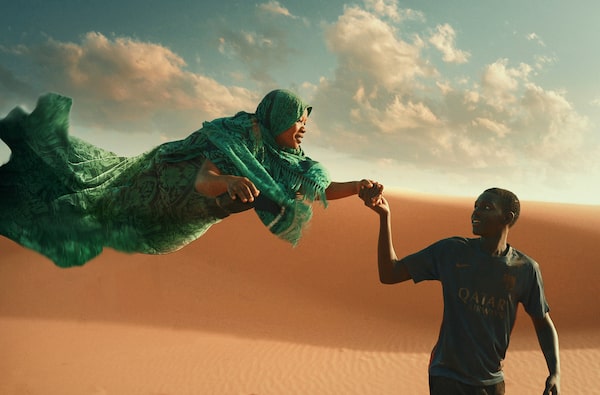
A scene from Matteo Garrone's new film lo Capitano: 'We based this on true stories to show how these people are victims of the system,' he says.The Associated Press
Half Homeric odyssey and half brutal exposé of the dangers that African migrants face in seeking asylum in Europe, Matteo Garrone’s new film Io Capitano feels like a stark departure for the Italian director behind the 2008 Mafia epic Gomorrah. Yet peer a little closer and the similarities stand out: Both films are about oppressive systems of power, and how they can so easily grind innocent men and women simply trying to make better lives for themselves.
Ahead of the film’s Canadian release this Friday – and a few weeks before the drama will compete for the best international feature Oscar at the Academy Awards – Garrone spoke with The Globe and Mail about crafting a story of horror and hope.
The construction of the film is interesting because it ends, without spoiling anything, just right where the headlines of the migrant crisis begin. Western audiences are well aware of what happens to migrants who make it to European shores, but we have no idea about the harsh voyage it took to get there.
That’s exactly what pushed us to tell this story, to explore the journey that we don’t see. We know what happens when they arrive – they start a whole new odyssey. We based this on true stories to show how these people are victims of the system. We wanted to give the audience the chance to relive an emotional experience, to go on this epic journey through the eyes of the young Senegalese man Seydou. And we made the movie together with real migrants, who helped us recreate it all.
You were working here with largely non-professional actors …
I mix, as I do often. There are professionals and others who are not. The real people, I was so impressed with their joy, their humanity, their bravery, the solidarity that they have with each other. This is also a movie about dreams, and the illusions that we create. Like when people from Europe send images to African countries through social-media showing how wonderful life in Europe is, which convince people to come. But when they arrive here, life is not easier at all.
On that dream note, there are a few touching moments in the film where you break away from the action to deliver these moments of magic realism, where we’re escaping into Seydou’s imagination.
Those moments give an opportunity for the audience to breathe. And when writing it, I wanted to show the inner feelings of Seydou. This is a coming-of-age story about a boy who becomes a man, but through his traumatic journey. So I wanted the audience to see what’s inside his mind, these wounds of the soul.
When you were making Gomorrah, you worked closely alongside real members of the Mafia. Here, did you connect with real Libyan traffickers?
We did a lot of research for this one. And we looked at photos, videos – and those videos can be really tough to watch. Sometimes when you recreate a world, you have to be careful to remain believable. And there were things that were too violent to include here and for it to remain believable for the audience.
Why did you feel that you – an Italian filmmaker, a white filmmaker – were the right person to tell this story of African migrants?
It took eight years to get this going. I was worried about entering a world that wasn’t mine, and when I first listened to the story of a young boy who had saved hundreds of lives of people at sea, I thought maybe it’s better if the movie was made by an African. But no one did it. So after eight years, I said, maybe if I try to make this movie with people who went through this experience – like having them on as co-directors, sharing everything together and trusting each other, and me trying to be a sort of intermediator – then it can come out authentic and true. The audiences will remember the movie, not who made it.
This interview has been condensed and edited.

Garrone describes lo Capitano as a coming-of-age story about Seydou, as he becomes a man through this traumatic journey.Greta De Lazzaris/The Associated Press
Review
Io Capitano
Directed by Matteo Garrone
Written by Matteo Garrone, Massimo Gaudioso, Massimo Ceccherini and Andrea Tagliaferri
Starring Seydou Sarr and Moustapha Fall
Classification N/A; 121 minutes
Opens in select theatres Feb. 23
Critic’s Pick
The latest film from acclaimed Italian director Matteo Garrone (2008′s Mafia epic Gomorrah) cannot help but be placed in conversation with the nascent genre of refugee cinema. On one end, there is Agnieszka Holland’s extraordinarily powerful Green Border from last year, tracing the turmoil of migrants caught between the Belarus-Poland border. On the other end is Sally El Hosaini’s 2022 safe and self-satisfied drama The Swimmers, which places a patina of inspirational underdog-sports melodrama atop a true story of two Syrian sisters who swam to freedom. Garrone’s Io Capitano falls somewhere between – intense and unflinching, with just a slight brush of broad-stroke emotion and narrative convenience to keep it from totally crushing the soul.
Following two Senegalese cousins, Seydou (Seydou Sarr) and Moussa (Moustapha Fall) as they leave Dakar for Italy, Garrone’s film starts with an intriguing assumption: Most European audiences already know what tragedy typically awaits refugees if they manage to arrive on their shores, yet few likely understand the hell those migrants endure en route. Thus Garrone spends the entirety of his film chronicling one traumatic hardship after another for Seydou and Moussa, with the two losing innocence along the way.
It is a frequently brutal, often riveting experience, with Garrone expecting if not demanding endurance of his audience. Do the film’s occasional dips into magical realism and extremely convenient twists occasionally rip the film away from the reality that Garrone presents as raw and true? Perhaps, but mostly Io Capitano offers an essential journey of understanding. B.H.
 Barry Hertz
Barry Hertz